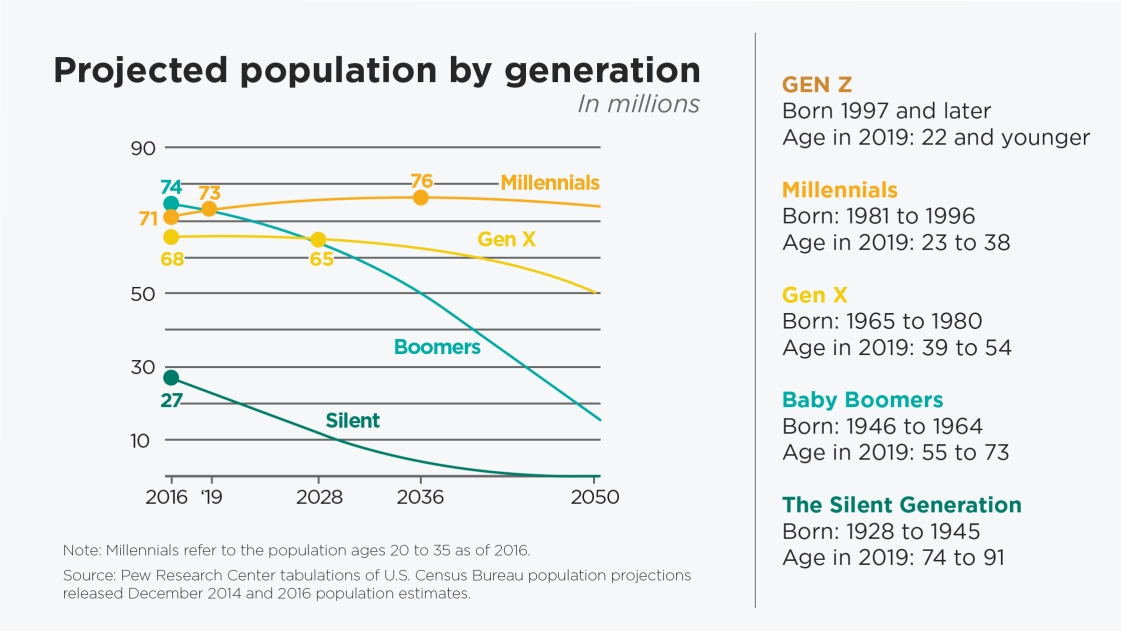Generational Shifts Impacting America’s Cities

Times change. It’s a simple fact of life. Each generation ushers in new lifestyles that impact the way our world functions—from the 1940s’ post war homes to the 1980s’ booming shopping malls to today’s technology-driven society. The ways in which each generation wants to work, play, and live strongly influences how municipalities and developers need to adapt in order to attract continued economic success.
As urban planners, we’re obsessed with societal trends that impact our economy—that includes our shifting demographics. As Millennials and Gen Z begin to overtake Baby Boomers and Gen X in the marketplace, we’re paying close attention to their preferences.
To give you some perspective of the power of today’s younger generations, consider this: in 2019 Millennials will surpass Baby Boomers as the nation’s largest living adult generation, according to population projections from the U.S. Census Bureau. Meanwhile, Gen Z already tops out at 86 million. Just check out these numbers:
This impacts three key areas of municipal planning:
1. Housing: It’s fairly well documented that Millennials prefer urban living. High-density housing is proving to be very attractive—and necessary—in growing cities.
However, that doesn’t necessarily mean we should end all other types of housing. The future is not set in stone. We must consider that as Millennials begin to have families, their needs might shift (that is IF they decide to have families). What other amenities will be key in attracting their interest? Will suburbs be able to offer the walkability and convenience younger adults crave? Or, will urban housing continue to rule? And, perhaps more importantly, will they be able to afford the homes on the market as they mature? These are all important factors as we build recommendations for housing.
2. Transportation: We also know that Millennials are less reliant on cars than older adults. According to the National Association of Realtors’ 2015 Community and Transportation Preference Survey, Millennials prefer walking as a mode of transportation by 12 percentage points over driving. They are the most likely age group to use public transportation and show a stronger preference for expanding public transportation and transportation alternatives to driving, such as biking and walking. The introduction of autonomous and connected vehicles as well as ride sharing will certainly also affect our roadways.
Improving roads and access to multi-modal transportation are often catalysts for economic development and can provide the community with better access to education, jobs, and healthcare.
3. Retail: Despite the headlines, retail is not dead. It’s only evolving. Technology has changed the way we shop, and retailers are changing their strategies to attract Millennials—a demographic that carries $44 billion in buying power, according to Matthew Shay, CEO of the National Retail Federation.
Although Millennials have earned a reputation for viewing the world through a digital-first lens, a study from Accenture found some remarkable similarities between them and their predecessors, the Baby Boomers and Generation X.
Forty-one percent of all three groups said they practice “showrooming”—examining merchandise at a nearby retail store and then shopping for it online to find the lowest price. The high penetration of smartphones enable customers to search for an item easily, even while in a store.
In other words, Millennials haven’t stopped frequenting brick-and-mortar venues. In fact, interviews conducted at one of America’s largest shopping malls confirmed findings that many members of the digital generation actually prefer visiting stores to shopping online.
All this means there’s an opportunity—with smart planning—to revitalize America’s retail corridors, empty buildings, and underutilized assets.
These trends require you to consider how you’re planning for the future—whether you’re a small town, a suburban oasis, or an expanding big city. Check back in coming weeks to read in more detail how generational preferences are impacting our cities and towns as we delve deeper into each of these areas.

